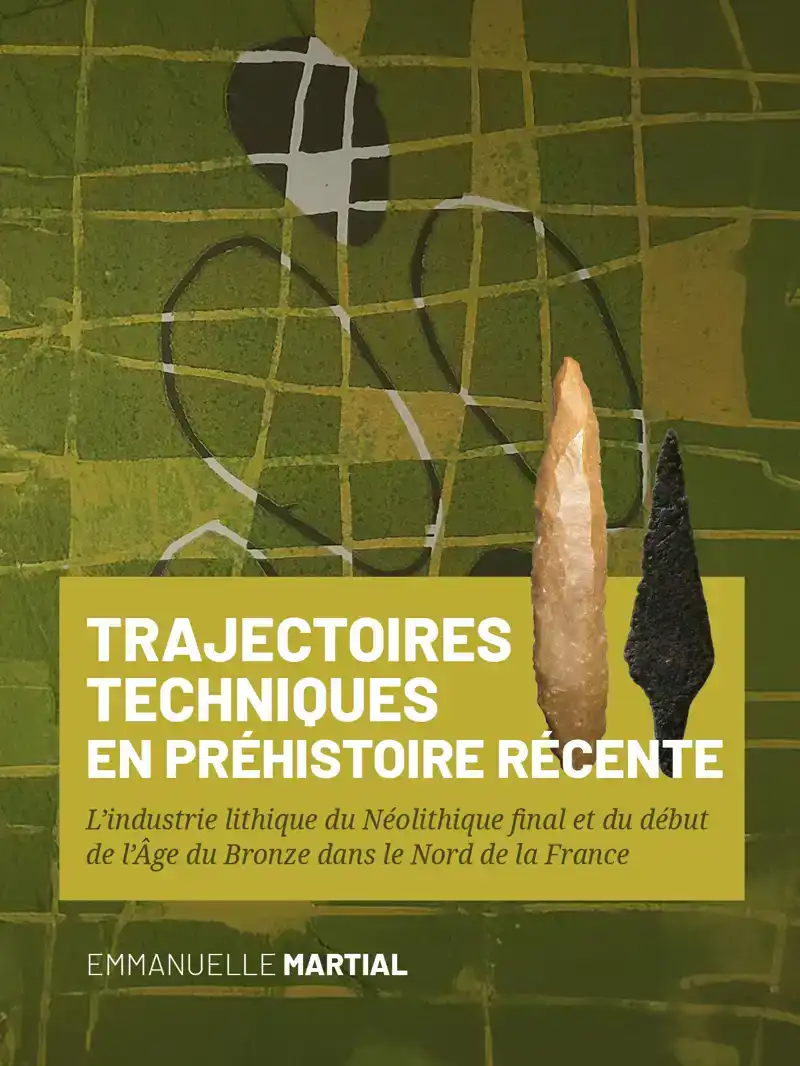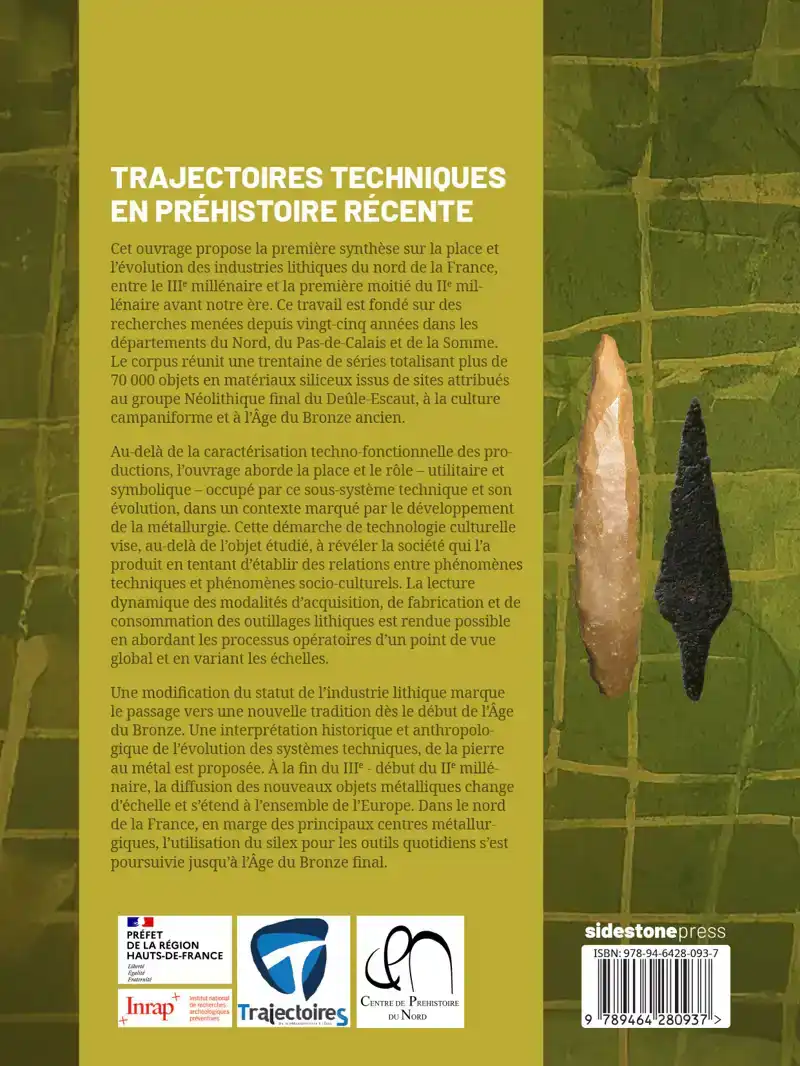- Andere Talen
- Franse Boeken
- TRAJECTOIRES TECHNIQUES EN PREHISTOIRE RECENTE
MARTIAL, EMMANUELLE
TRAJECTOIRES TECHNIQUES EN PREHISTOIRE RECENTE
60,00incl BTW
Nog niet verschenen. Wordt verwacht op: 16-09-2025
Vertrouwd sinds 1927
Persoonlijke aandacht en advies
Vanaf 17,50 gratis verzenden NL & BE
Meer dan 150.000 artikelen online
Omschrijving TRAJECTOIRES TECHNIQUES EN PREHISTOIRE RECENTE
Cet ouvrage propose la premiere synthese sur la place et l''evolution des industries lithiques du nord de la France, entre le IIIe millenaire et la premiere moitie du IIe millenaire avant notre ere. Ce travail est fonde sur des recherches menees depuis vingt-cinq annees dans les departements du Nord, du Pas-de-Calais et de la Somme. Le corpus reunit une trentaine de series totalisant plus de 70 000 objets en materiaux siliceux issus de sites attribues au groupe Neolithique final du Deule-Escaut, a la culture campaniforme et a l''Age du Bronze ancien.
Au-dela de la caracterisation techno-fonctionnelle des productions, l''ouvrage aborde la place et le role - utilitaire et symbolique - occupe par ce sous-systeme technique et son evolution, dans un contexte marque par le developpement de la metallurgie. Cette demarche de technologie culturelle vise, au-dela de l''objet etudie, a reveler la societe qui l''a produit en tentant d''etablir des relations entre phenomenes techniques etphenomenes socio-culturels. La lecture dynamique des modalites d''acquisition, de fabrication et de consommation des outillages lithiques est rendue possible en abordant les processus operatoires d''un point de vue global et en variant les echelles.
Une modification du statut de l''industrie lithique marque le passage vers une nouvelle tradition des le debut de l''Age du Bronze. Une interpretation historique et anthropologique de l''evolution des systemes techniques, de la pierre au metal est proposee. A la fin du IIIe - debut du IIe millenaire, la diffusion des nouveaux objets metalliques change d''echelle et s''etend a l''ensemble de l''Europe. Dans le nord de la France, en marge des principaux centres metallurgiques, l''utilisation du silex pour les outils quotidiens s''est poursuivie jusqu''a l''Age du Bronze final.
English abstract
This book offers the first synthesis on the place and evolution of lithic industries in northern France, between the 3rd millennium and the first half of the 2nd millennium BCE. This work is based on twenty-five years of research conducted in the departments of Nord, Pas-de-Calais, and Somme. The corpus comprises about thirty collections totaling more than 70,000 flint artifacts from sites attributed to the Final Neolithic group of Deule-Escaut, the Bell Beaker culture, and the Early Bronze Age.
Beyond the techno-functional characterization of productions, the book examines the place and role-both utilitarian and symbolic-of this technical subsystem and its evolution, within a context marked by the development of metallurgy. This cultural technology approach aims, beyond the studied object, to uncover the society that produced it by attempting to establish connections between technical and socio-cultural phenomena. A dynamic reading of the modalities of acquisition, manufacturing, and consumption of lithic tools is made possible by addressing operational processes from a global perspective and by varying the scales of analysis.
A shift in the status of lithic industries marks the transition to a new tradition at the beginning of the Bronze Age. A historical and anthropological interpretation of the evolution of technical systems, from stone to metal, is proposed. At the end of the 3rd millennium and the beginning of the 2nd millennium BCE, the diffusion of new metallic objects expanded in scale and extended across Europe. In northern France, on the periphery of major metallurgical centers, the use of flint for everyday tools continued until the Late Bronze Age.
Au-dela de la caracterisation techno-fonctionnelle des productions, l''ouvrage aborde la place et le role - utilitaire et symbolique - occupe par ce sous-systeme technique et son evolution, dans un contexte marque par le developpement de la metallurgie. Cette demarche de technologie culturelle vise, au-dela de l''objet etudie, a reveler la societe qui l''a produit en tentant d''etablir des relations entre phenomenes techniques etphenomenes socio-culturels. La lecture dynamique des modalites d''acquisition, de fabrication et de consommation des outillages lithiques est rendue possible en abordant les processus operatoires d''un point de vue global et en variant les echelles.
Une modification du statut de l''industrie lithique marque le passage vers une nouvelle tradition des le debut de l''Age du Bronze. Une interpretation historique et anthropologique de l''evolution des systemes techniques, de la pierre au metal est proposee. A la fin du IIIe - debut du IIe millenaire, la diffusion des nouveaux objets metalliques change d''echelle et s''etend a l''ensemble de l''Europe. Dans le nord de la France, en marge des principaux centres metallurgiques, l''utilisation du silex pour les outils quotidiens s''est poursuivie jusqu''a l''Age du Bronze final.
English abstract
This book offers the first synthesis on the place and evolution of lithic industries in northern France, between the 3rd millennium and the first half of the 2nd millennium BCE. This work is based on twenty-five years of research conducted in the departments of Nord, Pas-de-Calais, and Somme. The corpus comprises about thirty collections totaling more than 70,000 flint artifacts from sites attributed to the Final Neolithic group of Deule-Escaut, the Bell Beaker culture, and the Early Bronze Age.
Beyond the techno-functional characterization of productions, the book examines the place and role-both utilitarian and symbolic-of this technical subsystem and its evolution, within a context marked by the development of metallurgy. This cultural technology approach aims, beyond the studied object, to uncover the society that produced it by attempting to establish connections between technical and socio-cultural phenomena. A dynamic reading of the modalities of acquisition, manufacturing, and consumption of lithic tools is made possible by addressing operational processes from a global perspective and by varying the scales of analysis.
A shift in the status of lithic industries marks the transition to a new tradition at the beginning of the Bronze Age. A historical and anthropological interpretation of the evolution of technical systems, from stone to metal, is proposed. At the end of the 3rd millennium and the beginning of the 2nd millennium BCE, the diffusion of new metallic objects expanded in scale and extended across Europe. In northern France, on the periphery of major metallurgical centers, the use of flint for everyday tools continued until the Late Bronze Age.
Reviews
0.0/5.0
Gemiddelde uit 0 reviews
Meest behulpzame reviews
Nog geen reviews geschreven




